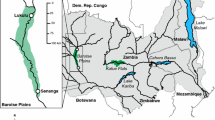Abstract
Three different layers have been identified in Framvaren, which has a maximum water depth of 184 m. One oxic layer above the redoxcline at 18–20 m. One anoxic layer from 20 to 100 m which is occasionally ventilated by a flow over the sill (which has a depth of 2.5 m), and finally a stagnant layer below 100 m. Using the release rate of silica from the bottom and measurements of the concentration of HTO it is possible to make some calculations on the annual volume of interleaving in the layers 25–50 m, 50–75 m, and 75–100 m together with the advective flows. Reliable values of the sulfide concentration were obtained by precipitating and weighing HgS together with careful protection of all anoxic water samples with argon. The light yellow color of the precipitate in the depth range 25 to 80 m indicates that the occasional ventilation will cause such reactions as 0.502 + H2S S(colloidal) + H2O. The elemental sulfur, being stabilized with HS−, is set free upon the precipitation of HgS. The new data for the concentration of sulfide give an acceptable stoichiometry for the decay reaction of organic matter. This is not the case with the data of Yao and Millero. The mean values for the concentrations of ammonium and phosphate agree with the new data of Yao and Millero. The mol/mol C/N ratio of 10.1 found in trapped material by Naess and coworkers (1988) agrees with the stoichiometry of the dissolved constituents, i.e. C/N = 9.92 ± 0.45. A denitrification reaction is suggested to explain the high values of C/N. The vertical diffusion coefficient at 100 m calculated from the depth profile of silica was 0.92 × 10−6 m2 s−1 which lies in the range of values given by Fröyland. Finally, the 14C age of the total dissolved inorganic carbon (Ct) in the water below 90 m was about 1600 years indicating a bioproduction in the period 8000 years B.P. to A.D. 1853 when a channel was opened between the fjord outside (Helvikfjord) and Framvaren.
Similar content being viewed by others
References
Anderson, L.G., Dyrssen, D., and Hall, P.O.J. (1988) On the sulphur chemistry of a super-anoxic fjord, Framvaren, South Norway. Mar. Chem. 23, 283–293.
Chierici, M. (1992) Bestämning av totalkarbonat i anoxiskt havsvatten. Stencilated examination paper at the Department of Analytical and Marine Chemistry, Gothenburg University.
Dyrssen, D. (1989) Biogenic sulfur in two different marine environments. Mar. Chem. 28, 241–249.
Dyrssen, D. and Svensson, T. (1982) On the calculation of release rates from stagnant basin sediments. Chem. Geology 36, 349–351.
Dyrssen, D and Wedborg, (1991) The sulphur-mercury (II) system in natural waters. Water, Air, and Soil Pollution 56, 507–519.
Fröyland, T. (1966) En oseanografisk undersökelse av Framvaren ved Farsund. Master's thesis, University of Bergen, Norway.
Johnson, K.M., Sieburth, Jr., McN., Williams, P.J. leB, and Brandstrom, L. (1987) Coulometric total carbon dioxide analysis for marine studies: Automation and calibration. Mar. Chem. 21, 117–133.
Millero, F.J. (1991) The oxidation of H2S in Framvaren Fjord. Limnol. Oceanogr. 36, 1007–1014.
Murayama, T., Sawaki, T., and Sakuraba, S. (1970) Anodic process of thiosulfate at a dropping mercury electrode. Bull. Chem. Soc. Japan 43, 2820–2823.
Naes, K., Skei, J.M., and Wassmann, P. (1988) Total particle and organic fluxes in anoxic Framvaren waters. Mar. Chem. 23, 257–268.
Nelson, D.M., Tréguer, P., Brzezinski, M.A., Leynaert, A., and Quéguiner, B. (1995) Production and dissolution of biogenic silica in the ocean: Revised global estimates, comparison with regional data and relationship to biogenic sedimentation. Global Biogeochemical Cycles 9, 359–372.
Ostlund, H.G. (1987) Tritium. In Geosecs Atlantic, Pacific, and Indian Ocean Expeditions Vol. 7, Shorebased Data and Graphics.
Partington, J.R. (1947) General and Inorganic Chemistry, Macmillan, London.
Rutgers van der Loeff, M.M., Anderson, L.G., Hall, P.O.J., Iverfeldt, ÅA., Josefson, A.B., Sundby, B., and Westerlund, S.F.G. (1984) The asphyxiation technique: An approach to distinguishing between molecular diffusion and biologically mediated transport at the sediment-water interface. Limnol. Oceanogr. 29, 675–686.
Skei, J.M. (1983) Geochemical and sedimentological considerations of a permanently anoxic fjord-Framvaren, South Norway. Sedimentary Geology 36, 131–145.
Skei, J. (1986) Framvaren Data Report 1931–1985. Norwegian Institute for Water Research (NIVA)No. F-80400, Oslo, Norway.
Skei, J.M. (1988) Framvaren — environmental setting. Mar. Chem. 23, 209–218.
Svensson, T. (1980) Tracer measurement of mixing in the deep water of a small, stratified sill fjord. In H.J. Freeland, D.M. Farmer, and C.D. Levings (eds.), Fjord Oceanography, pp. 233–240, Plenum Press, New York, 715 pp.
Stigebrandt, A. and Molvaer, J. (1988) On the water exchange of Framvaren. Mar. Chem. 23, 219–228.
Tréguer, P., Nelson, D.M., Van Bennekom, A.J., DeMaster, D.J., Leynaert, A., and Quéguiner, B. (1995) The silica balance in the world ocean: A reestimate. Science 268, 375–379.
Yao, W. and Millero, F.J. (1995) The chemistry of the anoxic waters in the Framvaren fjord, Norway. Aquatic Geochemistry 1, 53–88.
Author information
Authors and Affiliations
Rights and permissions
About this article
Cite this article
Dyrssen, D.W., Hall, P.O.J., Haraldsson, C. et al. Time dependence of organic matter decay and mixing processes in Framvaren, a permanently anoxic fjord in South Norway. Aquat Geochem 2, 111–129 (1996). https://doi.org/10.1007/BF00121627
Received:
Revised:
Issue Date:
DOI: https://doi.org/10.1007/BF00121627




